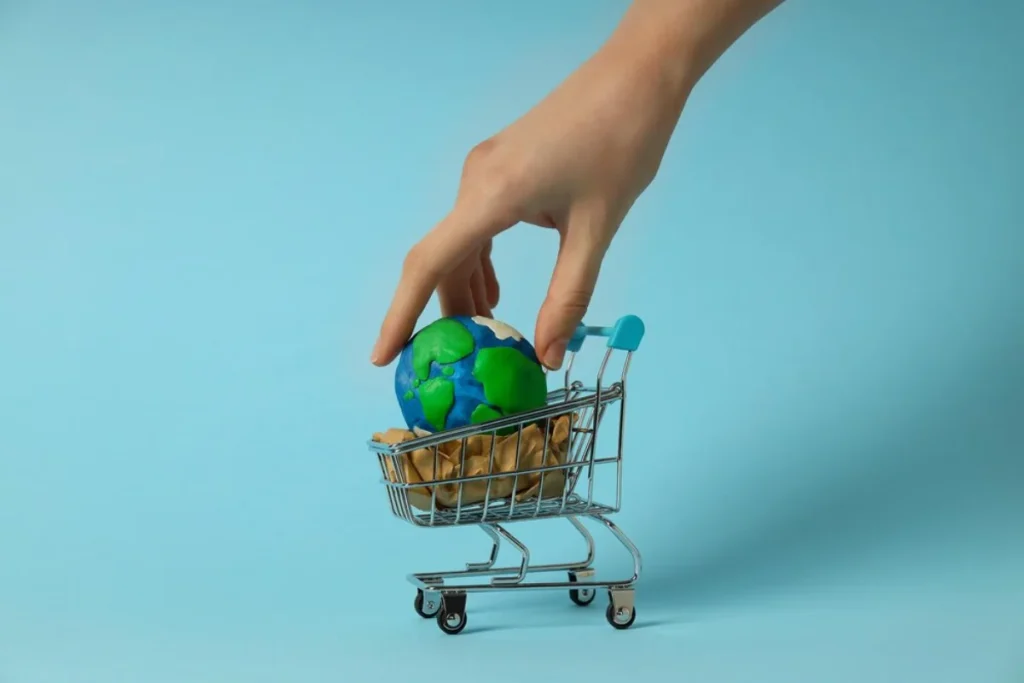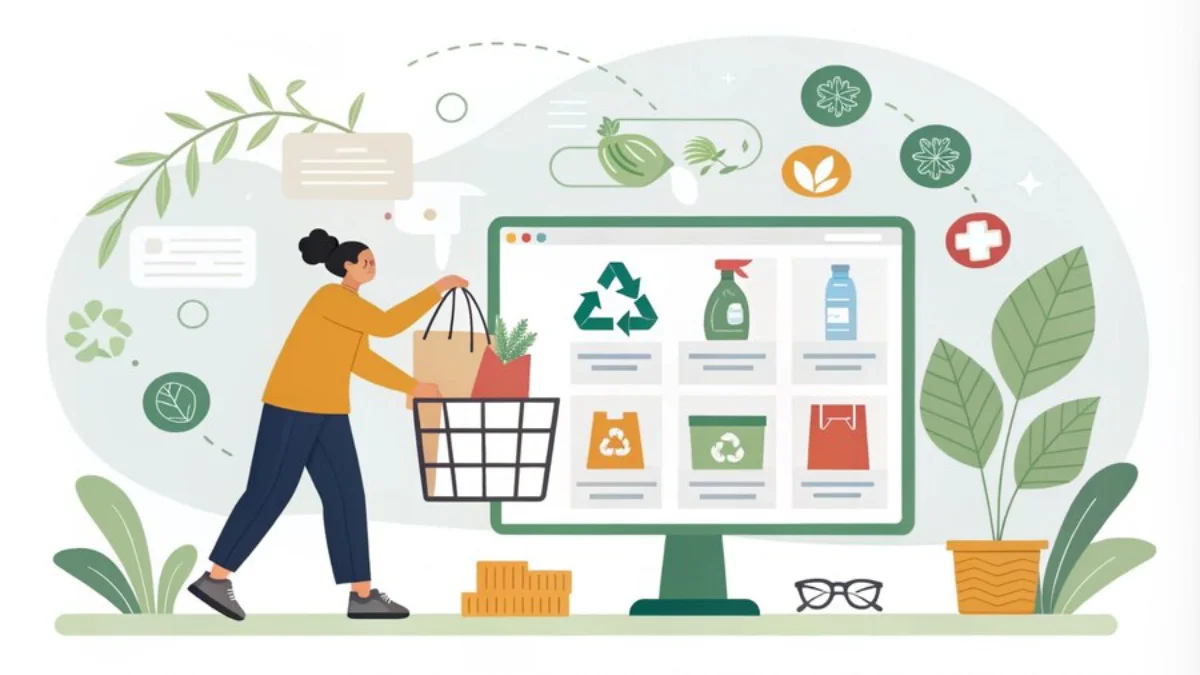The E-commerce Blog

The Rise of Ethical Consumerism in E-commerce
The Shift Towards Ethical Consumerism
In recent years, ethical consumerism has moved from a niche movement to a global shift in shopping habits. More consumers are focusing on ethical values when they shop. This change occurs as climate change, social justice, and environmental sustainability become more important. This change is clear in sustainable e-commerce. Businesses are adapting to green shopping trends. They offer eco-friendly products, ethical sourcing, and clear supply chains.
The rapid growth of online shopping presents both challenges and opportunities for sustainability. Digital retail cuts some environmental impacts of physical stores, like energy use and land use. However, it also brings problems, such as too much packaging, carbon emissions from delivery, and ethical labour issues. This article looks at why ethical consumerism is growing. We’ll see how e-commerce brands are reacting and what the future may bring for sustainable e-commerce.
Understanding Ethical Consumerism

What is Ethical Consumerism?
Ethical consumerism means buying products based on moral, environmental, and social values. Ethical consumers choose brands that:
- Prioritise sustainability by using eco-friendly materials and reducing waste.
- Engage in fair trade practices that ensure fair wages and humane working conditions.
- Support social causes, such as gender equality, racial diversity, and animal welfare.
- Ensure supply chain transparency by avoiding exploitative labour and unethical sourcing.
This movement lets consumers vote with their wallets. This pushes businesses to adopt responsible practices to keep trust and loyalty.
The Growth of Ethical Consumerism in E-commerce
Recent research highlights the increasing demand for sustainable e-commerce:
- 81% of global consumers feel companies should be environmentally responsible (IBM, 2021).
- 73% of millennials are willing to pay more for sustainable goods (Nielsen, 2022).
- 50% of consumers look for details on a company’s ethical and environmental efforts before they buy (Deloitte, 2023).
These statistics indicate that ethical shopping is no longer a niche preference. It is an expectation from modern consumers.
Key Factors Driving Ethical Consumerism
1. Environmental Awareness
Consumers are increasingly aware of the environmental impact of their purchases. Climate change talks, documentaries, and social media have made sustainability important for shoppers. Major concerns include:
- Plastic pollution: Single-use plastics contribute to ocean waste and environmental degradation.
- Carbon footprint: The logistics and delivery processes of e-commerce generate significant emissions.
- Deforestation: Making certain products destroys habitats and reduces biodiversity.
2. Transparency and Accountability
Thanks to digital advancements, consumers can easily research and scrutinise brands’ ethical commitments. Companies that aren’t transparent or don’t follow sustainable practices face backlash. This often leads to boycotts or harm to their reputation.
E-commerce brands that share their sustainability efforts build trust and loyalty. This includes details on sourcing, carbon footprints, and ethical certifications.
3. Social and Ethical Labour Practices
Ethical consumerism is more than just caring for the environment. It also includes fair wages, ethical labour practices, and social justice issues. Consumers want brands to follow responsible labour policies. They expect workers in supply chains to earn fair wages and work in humane conditions.
Brands that back fair trade, diversity, and community programs connect more with today’s consumers.
How E-commerce Brands are Adapting to Sustainable Shopping Trends
1. Sustainable Product Sourcing
E-commerce businesses are choosing sustainably sourced materials. This helps them meet the demands of ethical consumers. Key strategies include:
- Using recycled or biodegradable materials in clothing, packaging, and household items.
- Supporting local artisans and fair trade initiatives to ensure ethical labour practices.
- Offering organic and cruelty-free products in industries like beauty, fashion, and food.
Popular e-commerce brands like Patagonia, Veja, and Allbirds thrive on sustainable sourcing.

2. Eco-Friendly Packaging Solutions
Excessive packaging is a significant environmental concern in e-commerce. Brands are addressing this issue through:
- Minimalist packaging that reduces unnecessary waste.
- Recyclable, compostable, and biodegradable materials to replace plastic.
- Refillable product models, where customers can return or refill product containers.
- Paperless receipts and digital invoices to minimise paper waste.
Lush and The Body Shop have started new packaging return and refill systems. This helps them cut down on their environmental impact.
3. Carbon-Neutral Delivery and Logistics
The e-commerce boom has raised shipping emissions. Delivery vehicles and air freight add a lot to carbon footprints. Brands are mitigating these impacts by:
- Offering carbon offset programs where consumers can opt for climate-neutral deliveries.
- Using electric delivery fleets and eco-friendly transportation options.
- Partnering with green logistics companies committed to sustainable transportation.
Amazon’s Climate Pledge Friendly program and DHL’s GoGreen program show how logistics companies are going green.
4. Ethical Business Practices and Fair Trade
Beyond environmental concerns, ethical consumerism promotes fair trade, workers’ rights, and community support. Businesses embracing fair labour practices ensure:
- Living wages and safe working conditions for employees and supply chain workers.
- Ethical sourcing of raw materials, ensuring no exploitation of workers.
- Transparency reports showcasing their sustainability commitments and ethical business model.
Brands like People Tree and Ethique are Fairtrade-certified. They have loyal customers because they care about social responsibility.
5. Promoting Circular Economy Models
A circular economy focuses on minimising waste by keeping products in use for as long as possible. Key strategies include:
- Second-hand and resale platforms allow consumers to buy and sell pre-owned goods.
- Repair and refurbishment services that extend product lifespan.
- Clothing and electronics take-back schemes ensure responsible recycling.
Platforms like Depop, ThredUp, and Refurbed have made re-commerce or reverse commerce popular. Now, second-hand shopping is easy and trendy.
Overcoming Challenges in Sustainable E-commerce
1. Higher Costs of Ethical Products
One of the biggest barriers to the widespread adoption of ethical consumerism is cost. Sustainable products often come at a premium due to:
- Higher-quality materials and ethical sourcing costs.
- Fair wages and improved working conditions.
- Environmentally friendly manufacturing processes.
Retailers can tackle this by:
- Offering flexible pricing models
- Providing eco-friendly discounts
- Sharing the long-term benefits of sustainable shopping
2. Greenwashing and Consumer Distrust
Many brands practice greenwashing. This means they market themselves as sustainable to attract eco-friendly shoppers. However, they often make no real ethical changes. This erodes trust. It makes it hard for consumers to tell real ethical brands from those that just use sustainability as a buzzword.
Solutions include:
- Third-party certifications, such as Fair Trade, B Corp, and Rainforest Alliance.
- Blockchain technology for supply chain transparency.
- Clear and honest sustainability reporting.
3. Balancing Speed and Sustainability
Fast shipping expectations in e-commerce often conflict with sustainability goals. Retailers must strike a balance by:
- Encouraging consumers to opt for slower, eco-friendly delivery options.
- Optimising warehouse locations to reduce transport emissions.
- Consolidating shipments to minimise packaging waste and fuel consumption.
The Future of Ethical Consumerism in E-commerce
1. AI and Data-Driven Sustainability
AI and machine learning help retailers improve supply chains. They cut waste and boost efficiency. AI-driven tools can:
- Predict demand to prevent overproduction and excess stock.
- Enhance inventory management, reducing waste.
- Recommend eco-friendly alternatives to consumers based on shopping habits.
2. Blockchain for Transparency
Blockchain technology is revolutionising sustainability by enabling end-to-end traceability in supply chains. Consumers can scan QR codes to verify product origins, ethical sourcing, and environmental impact.
3. Greater Consumer Activism
With the rise of social media, consumers are holding brands accountable like never before. Companies that don’t meet ethical standards risk losing market share. Brands that focus on sustainability will take their place.
Embracing Ethical Consumerism in E-commerce
The rise of ethical consumerism in sustainable e-commerce is more than just a trend. It is the future of retail. As consumers become more aware, brands need to focus on transparency. They should also invest in eco-friendly innovations and ethical business practices to remain competitive.
Are you an e-commerce business looking to embrace sustainability? Take action today by adopting ethical sourcing, reducing waste, and prioritising transparency. The future of e-commerce is green—make sure your brand is part of it.









